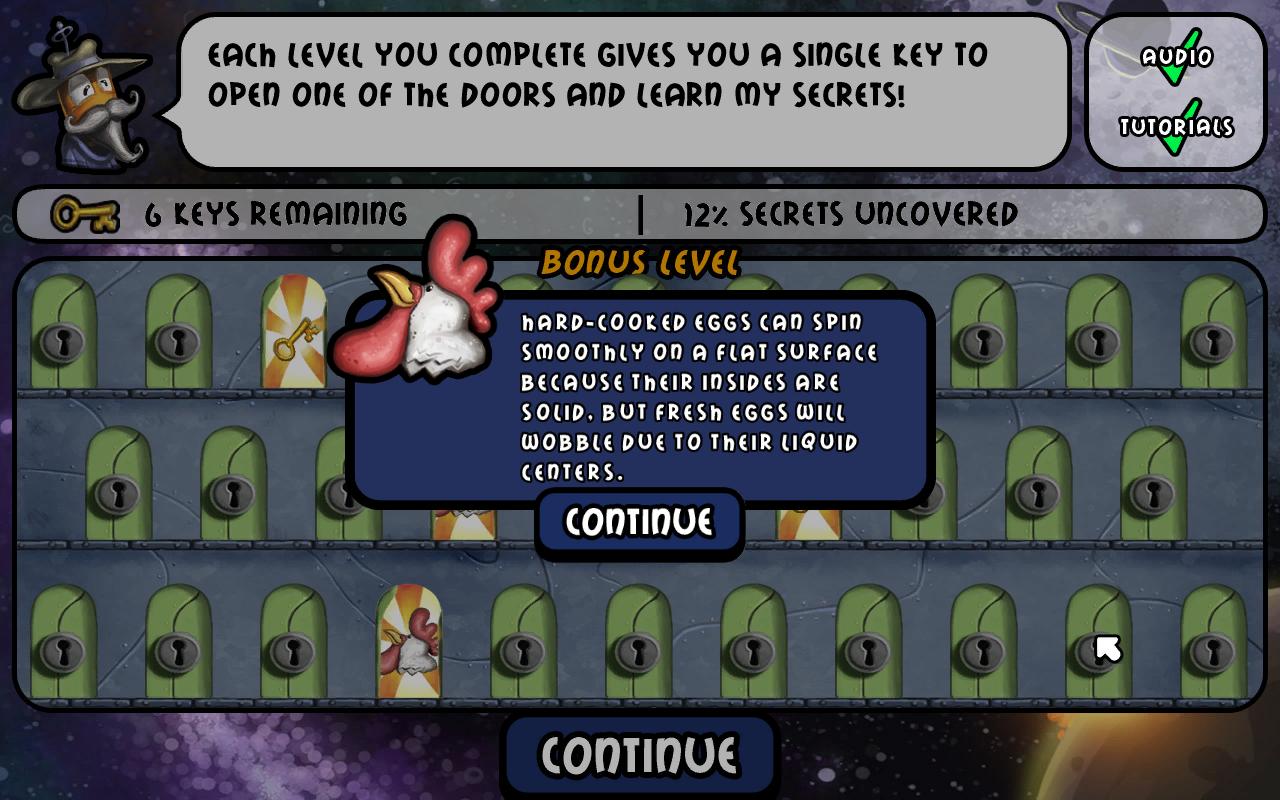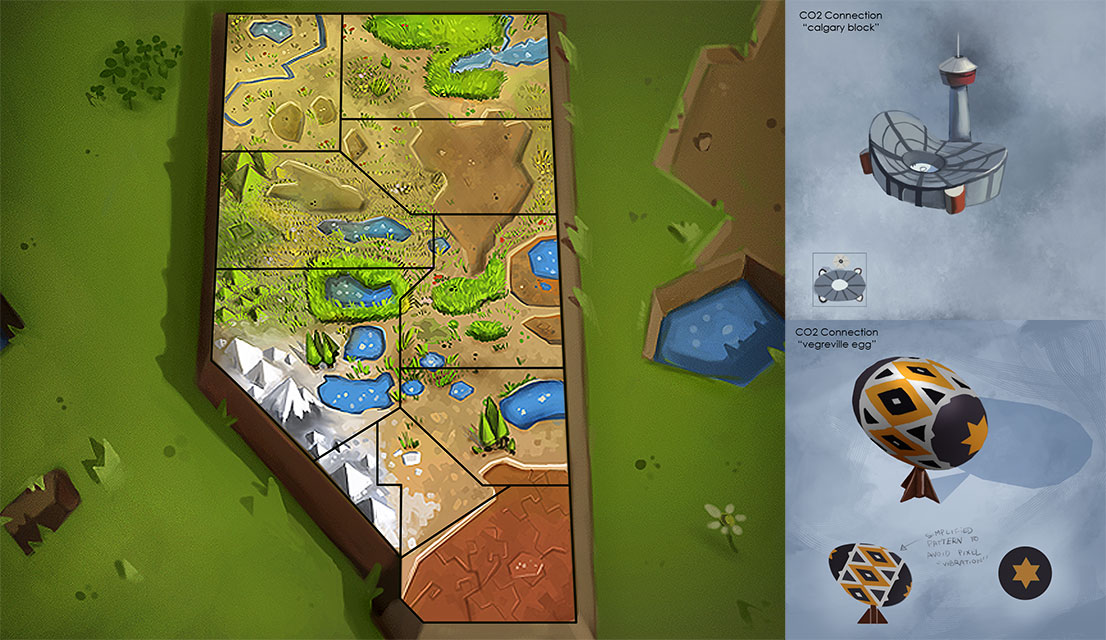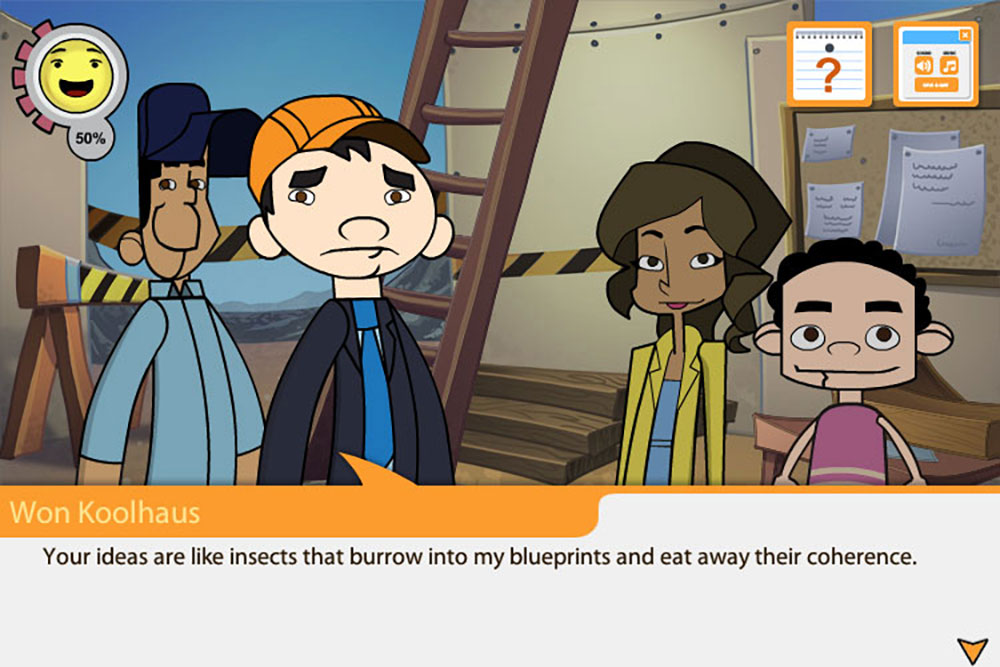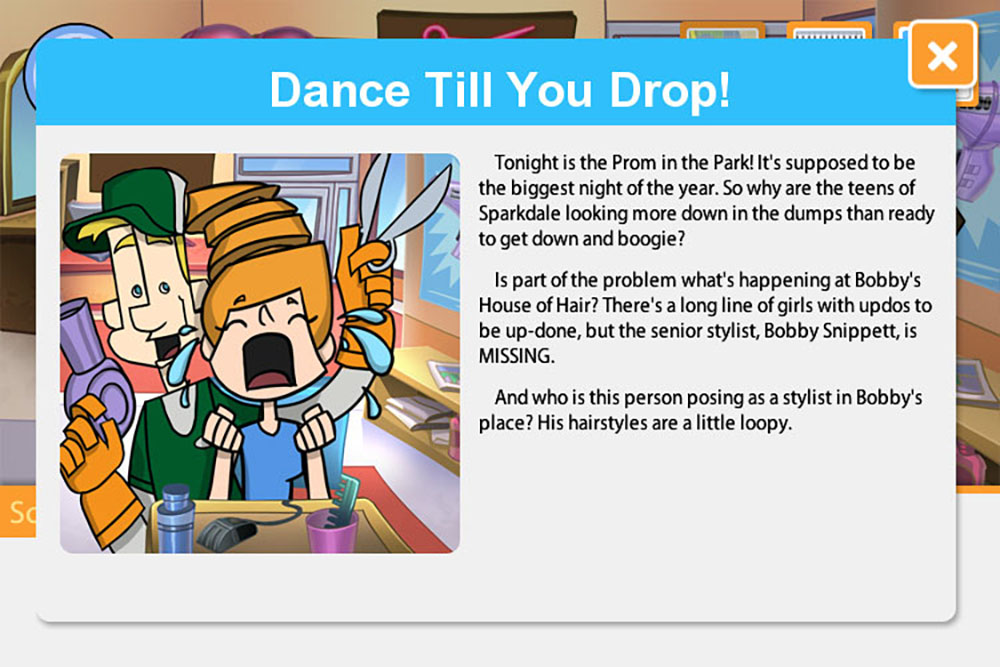Having performed design-consulting for Science Alberta prior to forming Incubator Games, our new team was approached with continuing the Kelvin series as our first work-for-hire project.
Kelvin’s Space Ranch began as a joint partnership between Alberta Milk and Alberta Egg with the aim to teach kids about local farming and produce processing. While these elements were thematically connected, they didn’t possess a unifying verb/noun coupling that could easily be turned into gameplay. Consequently, I decided to take a higher-level approach by grouping all possible tasks into a simplified time-management game in the vein of Diner Dash.

The sponsors loved this approach, but had one major caveat: the farming pens and processing facilities could not be placed in the same location due to health and safety concerns. This led me to propose the somewhat unusual sci-fi setting as it allowed us to split the screen in two with the use of a teleporter. This also had the benefit of smoothing over any specific differences to current-day technology while allowing Science Alberta to insert some extra information related to space research.

Our time-management approach tasked the player with various elements of animal care: giving them water, feeding them various types of food, cleaning their pens, and milking cows/gathering hen eggs. The produce was then taken to the proper processing machines for cleaning, turning into various products, and packaging.
Icons appeared over the appropriate pens and machines guiding players and providing some time-pressure to complete tasks before they expired. This was a straightforward approach the kids enjoyed — particularly the toilet-flushing sound of cleaning the pens — but the sponsors required additional details on the processing of the food products. To this end, we added time-pausing minimigames for grading eggs, pasteurizing milk, and various other processes of production.
Our second title for Science Alberta was The CO2 Connection, a game about building pipelines to sequester carbon dioxide emissions while extracting oil.
Once again, the project sponsors wanted to include detailed information on their industry, so I started by storyboarding minigames that would convey varied but intricate concepts of the work involved. These were paired down to extracting and compressing CO2, surveying potential storage sites, and sequestering carbon emissions.

While the client was satisfied with this approach, disparate minigames didn’t make for a cohesive experience. To better tie them together, I pitched the idea of traveling across Alberta to build a giant, linked pipeline.

Each of the 10 levels took place in a different part of the province and tasked the player with unveiling a fog-of-war to gather resources and discover CO2 producing hotspots. Once all CO2 nodes were linked with a pipeline, one of the minigames capped off the level.
The challenge of playing these maps was managerial, requiring the player to complete all connections before running out of turns or exhausting all available resources. To aid in this task, I took inspiration from board games like Battleship. Based on the revealed coordinates, the player could infer what was likely nearby. Cities and parks were also completely unveiled when one of their tiles was uncovered, and the player’s dog left paw tracks that always led to landmarks.

Much like Kelvin’s Space Ranch, The CO2 Connection was developed in Unity and received an iOS port simultaneously with the desktop release.
Following the completion of The CO2 Connection, the sponsors wanted to create followup game. This time the focus was placed on individual professions within the pipeline industry, giving birth to Project VRP.
Being weary of showcasing how badly things could go if these jobs were not performed up to standards, I suggested framing the game in a virtual-reality setting. This allowed players to make mistakes without facing drastic consequences, and proved a natural fit for a training-simulator motif.

The overall structure of Project VRP followed a semi-automated real-time strategy format. Players didn’t directly control units, but rather clicked on hotspots to choose which worker should seek them out to perform the required tasks. If the correct worker was chosen, the hotspot would disappear with a new one appearing until all the goals were completed.
The order of operations and the associated animations let players observe the pipeline creation process and — in time — learn the most efficient way to construct them.

Each level was split into four phases: planning, site prep, construction, and quality assurance. To prevent the player from being overwhelmed by the large quantity of jobs, each phase presented only a handful of units pertinent to the tasks at hand. Weather changes created additional randomized challenges, and a global speed boost allowed players to further optimize task-completion.
I created all level in the game by painting heatmaps in Photoshop that were interpreted as a 3D heightmap. This approach to topology allowed us to drastically alter the landscape and showcase exactly what each job entailed.

Like all other Science Alberta games, Project VRP received a desktop and iOS release, but included a kiosk build on top of that. The kiosk was a Windows-based standup arcade showcased at industry events, and proved popular enough that Incubator Games was commissioned to additionally create kiosk-ports for our other Science Alberta titles.
Developed for Career Cruising, ccSpark! is an episodic adventure game contained within a larger online package that includes administrative tools and additional student activities.
Much like Project VRP, ccSpark! aimed to educate kids about various professions, but was not limited to a single industry. Instead, 72 different careers were chosen across multiple fields and were showcased in 25 episodic adventures.

Each episode of the game featured a handful of locations occupied by humoursly confused residents. By conversing with these NPC’s, collecting items, recruiting companions, and choosing the correct progression-path, players learned about numerous real-world jobs and their requirements and responsibilities.
Curriculum links, character designs, and copy for the episodes was provided to Incubator Games, so our chief task was turning all this content into a game that was as accessible as possible. This led us to use the widely available Flash platform for development, and the whole experience was housed in a low-res website for maximum compatibility with classroom computers.

Game saving and selecting episodes was largely automated to minimize mistakes and extraneous UI, but I pushed for an extra-modular character creator so that every student could create an avatar that would approximate their own appearance.
Once in-game, each episode was introduced with a colourful splash image and a clear set of goals. To help guide players, the game’s cursor changed dynamically based on possible interactions, and a hint system was implemented to highlight unexplored areas and NPC dialogues.

While implementing the logic for all 25 episodes, I strove to include a few gameplay elements to encourage exploration and replayability. Befriending NPC’s in-game was duplicated on the website’s friend list, and all students could see which of their classmates were awarded extra badges for discovering hidden easter eggs.
As part of the project’s roadmap, I also provided a rough plan for future ccSpark! titles that were eventually pursued by Career Cruising.